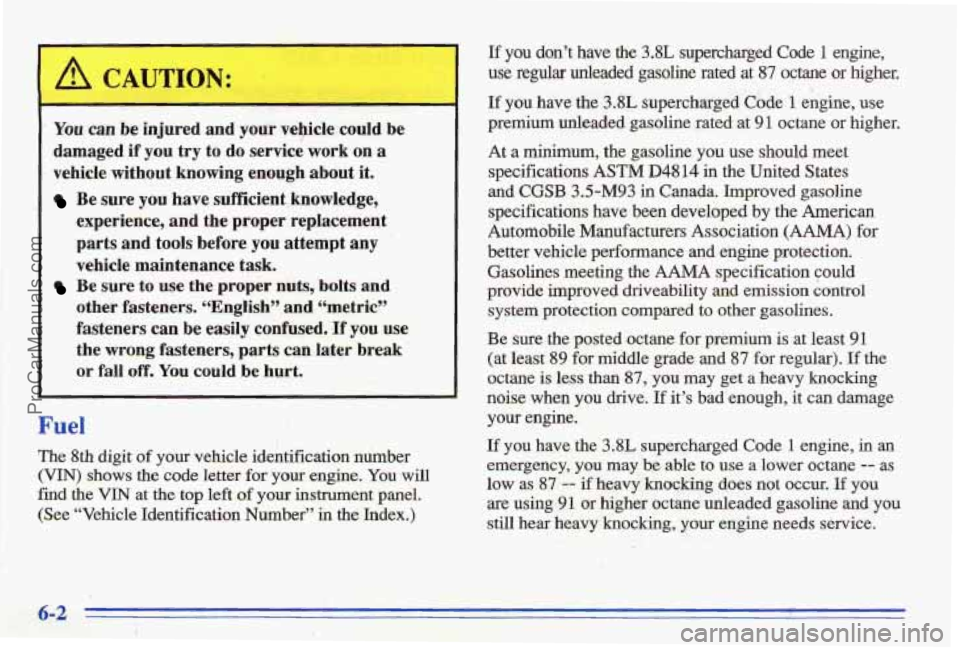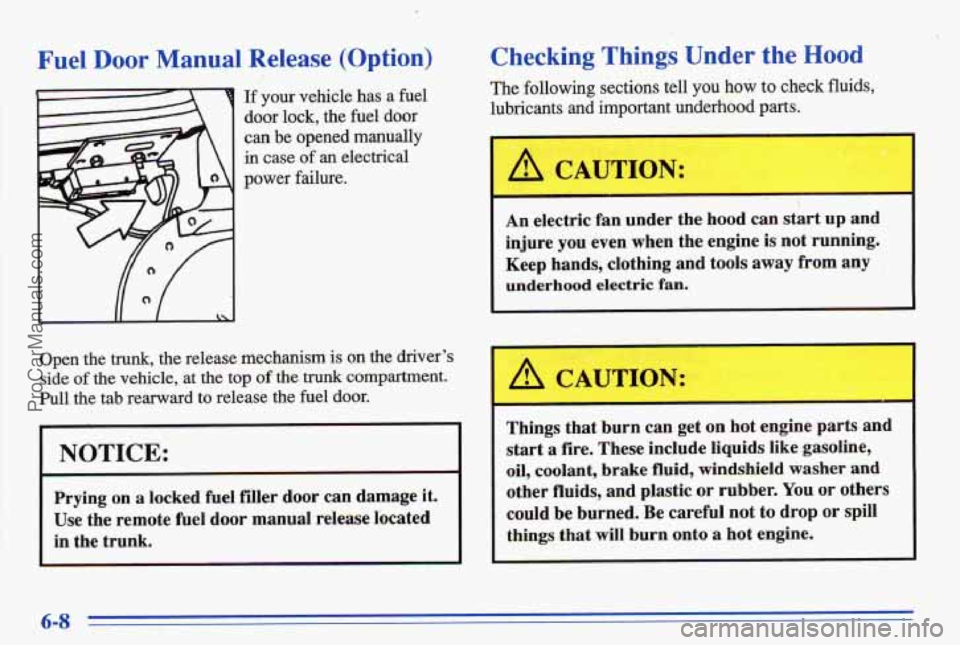Page 231 of 387
Changing a Flat Tire
If a tire goes flat, avoid fwther tire and wheel damage
by driving slowly to a level place, Turn on your hazard
warning flashers.
A CAUTION:
Changing a tire can cause an injury. The vehicle
can slip
off the jack and roll over you or other
people. You and they could be badly injured.
-Find a level place to change your tire. To help
prevent the vehicle from moving:
1. Set the parking brake firmly.
2. Put the shift lever in PARK (P).
3. lbrn off the engine.
To b'e even more certain the vehicle won't move,
you can put blocks
at. the front and rear of the
tire farthest away from the one being changed.
That would
be the tire on the other side of the
vehicle, at the opposite end.
The following steps will tell you how to use the jack and
c;lhange a tire.
ProCarManuals.com
Page 244 of 387

If You’re Stuck: In Sand, Mud,
Ice or Snow
What you don’t want to do when your vehicle is stuck is
to spin your wheels too fast. The method known as
“rocking” can help you get out when you’re stuck, but
you must use caution.
I
If you let your tires spin at high speed, they can
explode, and
you or others could be injured. And,
the transaxle
or other parts of the vehicle can
overheat. ,That could cause an engine
compartment fire or other damage. When you’re
stuck, spin the wheels
as little as possible. Don’t
spin the wheels above
35 mph (55 kmlh) as shown
on the speedometer.
NOTICE:
Spinning your wheels can destroy parts of your
vehicle
as well as the tires. If you spin the wheels
too fast while shifting your transaxle back and
forth, you can destroy your transaxle.
For information about using tire chains on your vehicle,
see “Tire Chains” in the Index.
Rocking your vehicle to get ‘it out:
First, turn your steering wheel left and right. That
will
clear the area around your front wheels. If your vehicle
has traction control, you should turn the system off. (See
“Traction Control System”
in the Index.) Then shift
back
and forth between REVERSE (R) and a forward
gear, spinning the wheels as little as possible. Release
the accelerator pedal while you shift,
and press lightly
on the accelerator pedal when the transaxle
is in gear. If
that doesn’t get you out after a few tries, you may need
to be towed out. If you do need to be towed out, see
“Towing Your Vehicle”
in the Index.
ProCarManuals.com
Page 247 of 387

You can be injured and your vepicle could be
damaged
if‘ you try to do service work on a
vehicle without knowing enough about it.
Be sure you have sufficient .knowledge,
experience,
and the proper replacement
parts and tools before you attempt any
vehicle maintenance task.
Be sare to use the proper nuts, bolts and
other fasteners. %nglishs’ and “metric”
fasteners can be easily confhsed.
If you use
the wrong fasteners, parts can later break ‘
or fall off. You could be hurt. ,.
Fuel .. b ’ .’. ‘ _. . .. ,. --
-The 8th digit of your vehicle identification number .. I
(VIN) shows the code letter for your engine. You ,will
find the VIN at the top left of your instrument panel.
(See “Vehicle Identification Number”
m the Index.)
’Y i,
If you don’t have the 3.8L supercharged Code 1 engine,
use regular unleaded gasoline rated at 87 octane or higher.
If you have the 3.8L supercharged, Code 1 ehgine, use
premium unleaded gasoline rated at 9 1 octane or higher.
At a
minimum, the gasoline you use should meet
specifications
ASTM I34814 in the United States
and CGSB 3.5-M93 in Can& Improved gasoline
specifications have been developed by the American
Automobile Manufacturers Association
(AAMA) for
better vehicle performance and ehgine protection.
Gasolims meeting the AAMA specification could
provide
improved driveability and emission control
system protkction compared to other gasolines.
Be sure
the posted octane for premium is at least 91
(at least 89 for middle grade and 87 for regular), I€ the
octane is
less than 87, you may get a heavy knocking
noise when you drive. If it’s bad-enough, it can damage
your engine.
. If you have the 3.8L supercharged Code 1 engine, in an
emergency, you may be able to use a lower octane -- as
low as 87 -- if heavy knocking does not occur. If you
are using 91 or higher octane unleaded gasoline and you
still hear heavy knocking, YQW engine needs service.
/
ProCarManuals.com
Page 248 of 387

If you’re using fuel rated at the recommended octane or
higher and you stiil hear heavy knocking, your engine
needs service. But don’t worry
if you hear a little
pinging noise when you’re accelerating or driving up
a
hill. That’s normal, and you don’t have to buy a higher \
octane fuel to get rid of pinging. It’s the heavy, constant
knock that means you have a problem.
If your vehicle is certified to meet California Emission
Standards (indicated on the underhood tune-up ’label),
it is designed to operate on fuels that meet California
specifications.
If such fuels are not available in states
adopting California emissions standards, your vehicle
will operate satisfactorily on fuels meeting federal
specifications, but emission control system performance
may be eected. The malfunction indicator lamp on
your instrument panel may turn on and/or-your vehicle may fail a smog-check test.
If this occurs, return to your
authorized Pontiac dealer for diagnosis to determine the
cause of failure.
In the event it is determined that the
cause
of the condition is the type of fuels used, repairs
may not be covered by your warranty.
In Canada, some gasolines contain an octane-enhancing
additive called MMT.
If you use such fuels, your
, emission control system performance may deteriorate
and the malfunction indicator lamp on your instrument
panel may turn on.
If this happens, return to your
authorized Pontiac dealer for service.
To provide cleaner air, all gasolines are now required to
contain additives that will help prevent deposits from
forming in your engine and fuel system, allowing your
emission control system to function properly. Therefore,
you should not have to add anything
to the fuel. In
addition, gasolines containing oxygenates, such as
ethers and ethanol, and reformulated gasolines may
be available in your area to help clean the air. General
Motors recommends that you use these gasolines
if
they mcomply with the specifications described earlier.
NOTICE:
Your vehicle was not designed for fuel that
contains methanol. Don’t use it. It can corrode
metal parts in your fuel system and also damage
plastic and rubber parts. That damage
wouldn’t
be covered under your warranty.
ProCarManuals.com
Page 251 of 387
While refueling, hang the cap inside the he1 door. If you have the (L36)~ 3800 V6 engine, your fuel cap
will be tethered and yw cannot hang it on the inside fuel
door while refueling.
To take off the cap, turn it slowly to the left
(counterclockwise),
6-6
ProCarManuals.com
Page 253 of 387

Fuel Door Manual Release (‘Option)
L
If your vehicle has a fuel
door lock, the fuel door
can be opened manually
in case of an electrical
power
failure.
Y
Open the trunk, the release mechanism is on the driver’s
side
of the vehicle, at the top of the trunk compartment.
Pull the tab rearward
to release the fuel door.
NOTICE:
Prying on a locked fuel filler door can damage it.
Use the remote fuel door manual release located
in the trunk.
Checking T,hings Under the Hood
The following sections tell you how to check fluids,
lubricants and important underhood
parts.
A CAUTION:
i
An electric fan under the hood can start up and
injure you even when the engine
is not running.
Keep hands, clothing and tools away from any
underhood electric fan.
A CAUTION:
Things that burn can get on hot engine parts and
start
a fire. These include liquids like gasoline,
oil, coolant, brake fluid, windshield washer and
other fluids,
and plastic or rubber. You or others
could be burned. Be careful not to drop
or spill
things that will burn onto a hot engine.
6-8
ProCarManuals.com
Page 255 of 387
3800 Series I1 Engine (L36 - Code K)
When you open the bod, you’ll see:
A. Engine Coolant Recovery Tank
B. Battery
C. Radiator Pressure Cap
D. Engine Oil Dipstick G. Brake Master Cylinder
E. Engine Oil Fill Cap H. Air Cleaner
F. Automatic
Transaxle Fluid Dipstick I. Windshield Washer Fluid Reservoir
6-10
ProCarManuals.com
Page 256 of 387
3800 Supercharged Engine (L67 - Code 1) (Option)
When you open the hood, ~011'11 see:
A. Engine Coolant Recovery Tank D. Engine Oil Dipstick G. Brake Master Cylinder
B. Battery
E. Engine Oil Fill Cap H. Air Cleaner
C. Radiator Pressure Cap F. Automatic Transaxle Fluid Dipstick I. Windshield Washer Fluid Reservoir
6-11
ProCarManuals.com